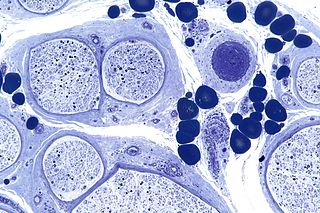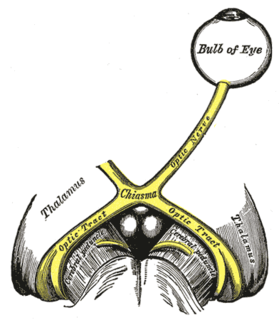| Look up neuropathy in Wiktionary, the free dictionary. |
Neuropathy may refer to:
- Peripheral neuropathy, a condition affecting the nerves of the peripheral nervous system
- Cranial neuropathy, any condition affecting cranial nerves
- Auditory neuropathy, any condition affecting the auditory nerve
- Optic neuropathy, any condition affecting the optic nerve (including "Leber's hereditary optic neuropathy")
- Diabetic neuropathy, peripheral neuropathy due to diabetes mellitus
- Familial amyloid neuropathies, a rare group of autosomal dominant neuropathies of autonomic (and sometimes also sensory or motor) nerves
- Giant axonal neuropathy, a rare neurological disorder that causes disorganization of neurofilaments
- Hereditary neuropathy with liability to pressure palsy (HNPP), a peripheral neuropathy that affects the sensory and muscle nerves
- Neuropathy, ataxia, and retinitis pigmentosa (NARP), a condition that causes a variety of signs and symptoms chiefly affecting the nervous system
- Neuropathy target esterase, a protein (enzyme) that catalyzes (increases the rates of) chemical reactions
- Organophosphate-induced delayed neuropathy, a neuropathy caused by killing of neurons in the central nervous system, especially in the spinal cord, as a result of acute or chronic organophosphate poisoning
- Polyneuropathy, a neurological disorder that occurs when many peripheral nerves throughout the body malfunction simultaneously

Peripheral neuropathy, often shortened to neuropathy, is a general term describing disease affecting the peripheral nerves, meaning nerves beyond the brain and spinal cord. Damage to peripheral nerves may impair sensation, movement, gland or organ function depending on which nerves are affected; in other words, neuropathy affecting motor, sensory, or autonomic nerves result in different symptoms. More than one type of nerve may be affected simultaneously. Peripheral neuropathy may be acute or chronic, and may be reversible or permanent.
Auditory neuropathy (AN) is a variety of hearing loss in which the outer hair cells within the cochlea are present and functional, but sound information is not faithfully transmitted to the auditory nerve and brain properly. Also known as auditory neuropathy/auditory dys-synchrony (AN/AD) or auditory neuropathy spectrum disorder (ANSD).
Optic neuropathy is damage to the optic nerve from any cause. Damage and death of these nerve cells, or neurons, leads to characteristic features of optic neuropathy. The main symptom is loss of vision, with colors appearing subtly washed out in the affected eye. On medical examination, the optic nerve head can be visualised by an ophthalmoscope. A pale disc is characteristic of long-standing optic neuropathy. In many cases, only one eye is affected and patients may not be aware of the loss of color vision until the doctor asks them to cover the healthy eye.
- Contrasts
- Neuropathy contrasts with terms describing problems in other parts of the nervous system such as:

Radiculopathy, also commonly referred to as pinched nerve, refers to a set of conditions in which one or more nerves are affected and do not work properly. This can result in pain, weakness, numbness, or difficulty controlling specific muscles.
Neuromuscular junction disease is a medical condition where the normal conduction through the neuromuscular junction fails to function correctly.
Myopathy is a disease of the muscle in which the muscle fibers do not function properly. This results in muscular weakness. Myopathy means muscle disease. This meaning implies that the primary defect is within the muscle, as opposed to the nerves or elsewhere. Muscle cramps, stiffness, and spasm can also be associated with myopathy.

The nervous system is the part of an animal that coordinates its actions by transmitting signals to and from different parts of its body. The nervous system detects environmental changes that impact the body, then works in tandem with the endocrine system to respond to such events. Nervous tissue first arose in wormlike organisms about 550 to 600 million years ago. In vertebrates it consists of two main parts, the central nervous system (CNS) and the peripheral nervous system (PNS). The CNS consists of the brain and spinal cord. The PNS consists mainly of nerves, which are enclosed bundles of the long fibers or axons, that connect the CNS to every other part of the body. Nerves that transmit signals from the brain are called motor or efferent nerves, while those nerves that transmit information from the body to the CNS are called sensory or afferent. Spinal nerves serve both functions and are called mixed nerves. The PNS is divided into three separate subsystems, the somatic, autonomic, and enteric nervous systems. Somatic nerves mediate voluntary movement. The autonomic nervous system is further subdivided into the sympathetic and the parasympathetic nervous systems. The sympathetic nervous system is activated in cases of emergencies to mobilize energy, while the parasympathetic nervous system is activated when organisms are in a relaxed state. The enteric nervous system functions to control the gastrointestinal system. Both autonomic and enteric nervous systems function involuntarily. Nerves that exit from the cranium are called cranial nerves while those exiting from the spinal cord are called spinal nerves.
Encephalopathy means any disorder or disease of the brain, especially chronic degenerative conditions. In modern usage, encephalopathy does not refer to a single disease, but rather to a syndrome of overall brain dysfunction; this syndrome can have many different organic and inorganic causes.
Myelopathy describes any neurologic deficit related to the spinal cord. When due to trauma, it is known as (acute) spinal cord injury. When inflammatory, it is known as myelitis. Disease that is vascular in nature is known as vascular myelopathy. The most common form of myelopathy in human, cervical spondylotic myelopathy (CSM), is caused by arthritic changes (spondylosis) of the cervical spine, which result in narrowing of the spinal canal ultimately causing compression of the spinal cord. In Asian populations, spinal cord compression often occurs due to a different, inflammatory process affecting the posterior longitudinal ligament.
- See also
- Charcot–Marie–Tooth disease
- Neuropathia mucinosa cutanea
- Neuropathic arthropathy
- Neuropathic pain
- Neuropathic ulcer
- Neuropathology
- Neuropathology and Applied Neurobiology , medical journal

Charcot–Marie–Tooth disease (CMT) is one of the hereditary motor and sensory neuropathies, a group of varied inherited disorders of the peripheral nervous system characterized by progressive loss of muscle tissue and touch sensation across various parts of the body. Currently incurable, this disease is the most commonly inherited neurological disorder, and affects about one in 2,500 people. CMT was previously classified as a subtype of muscular dystrophy.
Neuropathia mucinosa cutanea is a cutaneous condition characterized by livedo reticularis on the legs and hyperesthesia.

Neuropathic arthropathy, also known as Charcot joint after the first to describe it, Jean-Martin Charcot, refers to progressive degeneration of a weight bearing joint, a process marked by bony destruction, bone resorption, and eventual deformity due to loss of sensation. Onset is usually insidious.
| This disambiguation page lists articles associated with the title Neuropathy. If an internal link led you here, you may wish to change the link to point directly to the intended article. |






